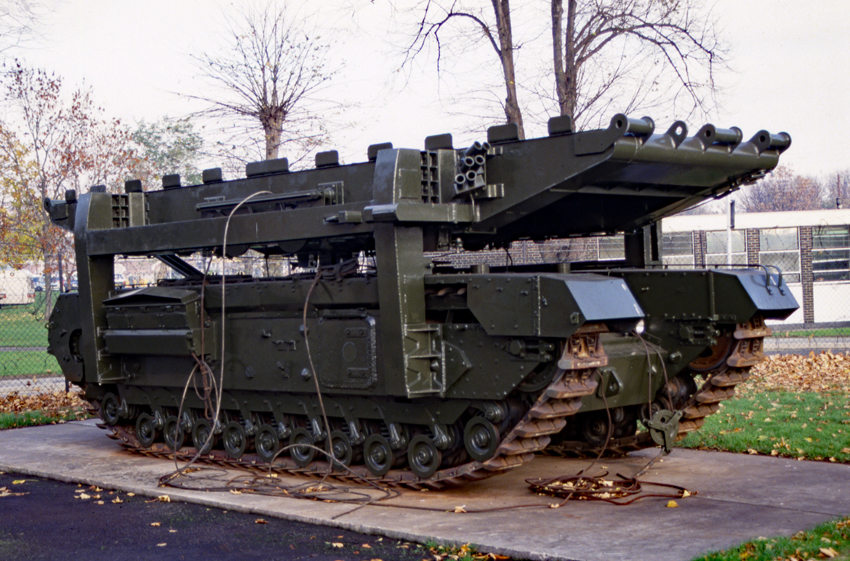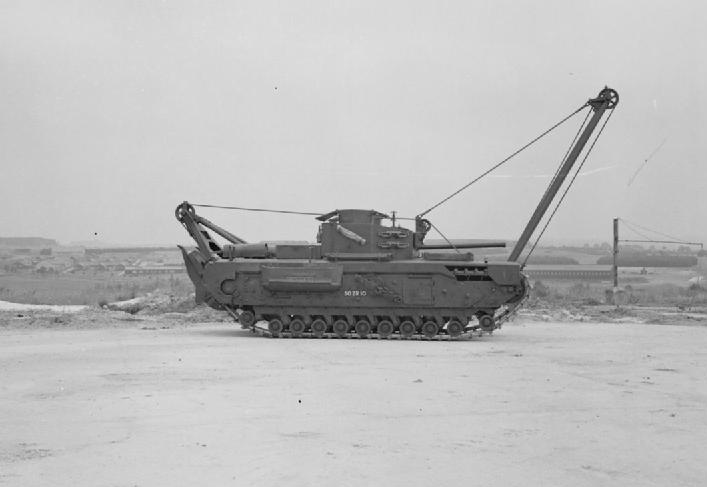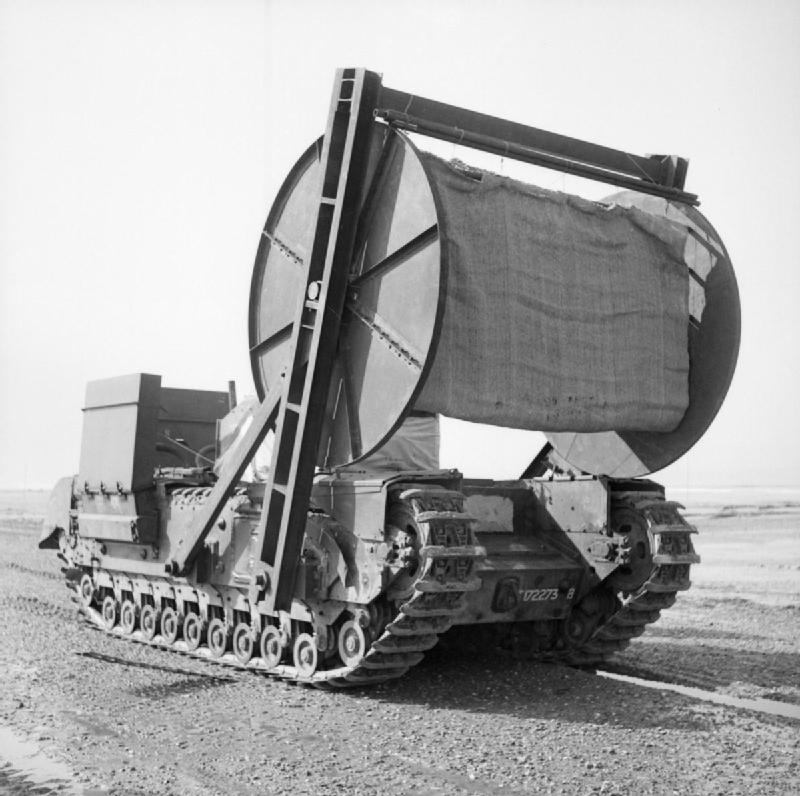|
AVRE
Armoured Vehicle Royal Engineers (AVRE), also known as Assault Vehicle Royal Engineers is the title given to a series of armoured military engineering vehicles operated by the Royal Engineers (RE) for the purpose of protecting engineers during frontline battlefield operations. In protecting engineers, the vehicles also became a mobile platform for a variety of engineering purposes, mounting large calibre weapons for demolition, carrying engineering stores, mine clearance explosives, a variety of deployable roadways, and modified engineering bridges for gaps that the related Armoured Ramp Carrier ("ARK") vehicles could not overcome. Development history Extremely high casualty rates among engineers was one of the primary reasons for the failure of the Dieppe raid of August 1942. Engineers were tasked with getting the tanks off the beach, destroying obstacles and building ramps. In the assault, the engineers were prone to gunfire while setting charges, and became a priority tar ... [...More Info...] [...Related Items...] OR: [Wikipedia] [Google] [Baidu] |
Hobart's Funnies
Hobart's Funnies is the nickname given to a number of specialist armoured fighting vehicles derived from tanks operated during the Second World War by units of the 79th Armoured Division of the British Army or by specialists from the Royal Engineers. They were designed in light of problems that more standard tanks experienced during the amphibious Dieppe Raid, so that the new models would be able to overcome the problems of the planned invasion of Normandy. These tanks played a major part on the Commonwealth beaches during the landings. They were forerunners of the modern combat engineering vehicle and took their nickname from the 79th Division's commander, Major General Percy Hobart. The vehicles converted were chiefly Churchill tanks, and American-supplied M4 Sherman tanks. History Plans to invade continental Europe were completely revised after the failure of the raid on Dieppe in 1942. Allied units in Normandy would need to overcome terrain, obstacles and coastal fortific ... [...More Info...] [...Related Items...] OR: [Wikipedia] [Google] [Baidu] |
Armoured Ramp Carrier
This is a list of specialist variants of the Churchill tank which were used for purposes other than frontline combat. Churchill Oke A Churchill II or III with a flamethrower. The Oke flamethrowing tank was named after its designer, Major J.M. Oke. The design was basically a Churchill tank fitted with the Ronson flamethrower equipment. A tank containing the flame fuel was fitted at the rear, with a pipe from it leading to the fixed angle mounting on the front hull to the left, leaving the hull machine gun unobstructed. Three (named "Boar", "Beetle" and "Bull") were present in the first wave at Dieppe; they were quickly lost, and abandoned. Assault Vehicle Royal Engineers Proposed by a Canadian engineer as a result of experience from the Dieppe Raid, the Assault Vehicle Royal Engineers (AVRE) was a Churchill Mark III or IV equipped with the "Mortar, Recoiling Spigot, Mark II" (or ''Petard''), a spigot mortar that throws the Bomb Demolition Number 1 ("Flying dustbin") wi ... [...More Info...] [...Related Items...] OR: [Wikipedia] [Google] [Baidu] |
Churchill Tank
The Tank, Infantry, Mk IV (A22) Churchill was a British infantry tank used in the Second World War, best known for its heavy armour, large longitudinal chassis with all-around tracks with multiple bogies, its ability to climb steep slopes, and its use as the basis of many specialist vehicles. It was one of the heaviest Allied tanks of the war. The origins of the Churchill's design lay in the expectation that war in Europe might be fought in conditions similar to those of the First World War, and thus emphasised the ability to cross difficult ground. The Churchill was hurried into production in order to build up British defences against a possible German invasion. The first vehicles had flaws that had to be overcome before the Churchill was accepted for wide use. After several Marks (versions) had been built, a better-armoured specification, the Mark VII, entered service with the British Army. The improved versions performed well in the later stages of the war. The Churchil ... [...More Info...] [...Related Items...] OR: [Wikipedia] [Google] [Baidu] |
79th Armoured Division
The 79th Armoured Division was a specialist armoured division of the British Army created during the Second World War. The division was created as part of the preparations for the Normandy invasion on 6 June 1944, D-Day. Major-General Percy Hobart commanded the division and was in charge of the development of armoured vehicles that were solutions to problems of the amphibious landing on the defended French coastline; these unusual-looking tanks it developed and operated were known as "Hobart's Funnies". They included tanks that floated, could clear mines, destroy defences, carry and lay bridges, and roadways. The practical use of these specialist tanks was confirmed during the landings on the beaches. Its vehicles were distributed as small units across the divisions taking part in the landings and subsequent operations. The division remained in action during the North-west European Campaign, providing specialised support during assaults to the 21st Army Group and, occasionally ... [...More Info...] [...Related Items...] OR: [Wikipedia] [Google] [Baidu] |
1st Assault Brigade Royal Engineers
The 1st Assault Brigade Royal Engineers was a specialised armoured formation of the British Army active in the Second World War. It was formed in mid-1943 and its structure was three assault regiments of the Royal Engineers. It was assigned to the 79th Armoured Division in preparation for the Normandy invasion of 6 June 1944. The unit comprised armoured vehicles modified for specialist roles (also known as Hobart's Funnies), intended to assist with the landing phase of the operation. History By the end of October 1943, various engineer units had been renamed and transferred into the Brigade. This brigade comprised 3 Assault Regiments, each with 4 Assault Squadrons, plus an Assault Park Squadron. This structure remained unchanged up to the Normandy landings in June 1944. The basic vehicle of the assault unit was the Assault Vehicle Royal Engineers (AVREs). This was a Churchill tank with its turret modified or removed and to which were attached certain special equipments ... [...More Info...] [...Related Items...] OR: [Wikipedia] [Google] [Baidu] |
Military Engineering Vehicle
A military engineering vehicle is a vehicle built for construction work or for the transportation of combat engineers on the battlefield. These vehicles may be modified civilian equipment (such as the armoured bulldozers that many nations field) or purpose-built military vehicles (such as the AVRE). The first appearance of such vehicles coincided with the appearance of the first tanks, these vehicles were modified Mark V tanks for bridging and mine clearance. Modern ''military engineering vehicles'' are expected to fulfill numerous roles, as such they undertake numerous forms, examples of roles include; bulldozers, cranes, graders, excavators, dump trucks, breaching vehicles, bridging vehicles, military ferries, amphibious crossing vehicles, and combat engineer section carriers. History World War One A Heavy RE tank was developed shortly after World War I by Major Giffard LeQuesne Martel RE. [...More Info...] [...Related Items...] OR: [Wikipedia] [Google] [Baidu] |
Chieftain Tank
The FV4201 Chieftain was the main battle tank of the United Kingdom during the 1960s–1990s. A development of the Centurion, the Chieftain introduced the supine (reclining) driver position to British design allowing a heavily sloped hull with reduced height. A new powerpack and improved transmission gave it higher speed than the Centurion despite being heavier due to major upgrades to armour protection and the armament; this allowed it to replace both the Conqueror and Centurion while performing their roles effectively. It remained in service until replaced by the Challenger 1 which shared many of the Chieftain's features. Development The Chieftain was an evolutionary development of the successful cruiser line of tanks that had emerged at the end of the Second World War. Its predecessor, the Centurion main battle tank (MBT), is widely considered to be one of the most successful of post-war MBT designs. However, the introduction of the Soviet IS-3 /IS-4 heavy tank along with S ... [...More Info...] [...Related Items...] OR: [Wikipedia] [Google] [Baidu] |
Fascine
A fascine is a rough bundle of brushwood or other material used for strengthening an earthen structure, or making a path across uneven or wet terrain. Typical uses are protecting the banks of streams from erosion, covering marshy ground and so on. In war they have often been used to help armiesin modern times, especially tanks and other vehiclescross trenches, valleys, marshes, muddy or uneven terrain, etc. Early military use Fascine bundles were used defensively for revetting (shoring up) trenches or ramparts, especially around artillery batteries, or offensively to fill in ditches and cross obstacles on a battlefield. Fascine bridges are a regularly attested feature of Roman military engineering and would have been widespread in the ancient world due to their usefulness and ease of construction. During the Siege of Alesia, the Gauls repeatedly attempted to repel the invading Romans by filling their trenches in with fascines and covering their traps, to support their counter ... [...More Info...] [...Related Items...] OR: [Wikipedia] [Google] [Baidu] |
Petard
A petard is a small bomb used for blowing up gates and walls when breaching fortifications. It is of French origin and dates back to the 16th century. A typical petard was a conical or rectangular metal device containing of gunpowder, with a slow match for a fuse. Etymology ''Pétard'' comes from the Middle French ''péter'', to fart, from the root ''pet'', expulsion of intestinal gas, derived from the Latin ''peditus'', past participle of ''pedere'', to break wind. In modern French, a ''pétard'' is a firecracker (and it is the basis for the word for firecracker in several other European languages). ''Pétardiers'' were deployed during sieges of castles or fortified cities. The ''pétard'', a rather primitive and exceedingly dangerous explosive device, comprised a brass or iron bell-shaped device filled with gunpowder and affixed to a wooden base called a ''madrier''. This was attached to a wall or gate using hooks and rings, the fuse lit and, if successful, the resulting ex ... [...More Info...] [...Related Items...] OR: [Wikipedia] [Google] [Baidu] |
D-day - British Forces During The Invasion Of Normandy 6 June 1944 B5040
The Normandy landings were the landing operations and associated airborne operations on Tuesday, 6 June 1944 of the Allied invasion of Normandy in Operation Overlord during World War II. Codenamed Operation Neptune and often referred to as D-Day, it was the largest seaborne invasion in history. The operation began the liberation of France (and later western Europe) and laid the foundations of the Allied victory on the Western Front. Planning for the operation began in 1943. In the months leading up to the invasion, the Allies conducted a substantial military deception, codenamed Operation Bodyguard, to mislead the Germans as to the date and location of the main Allied landings. The weather on D-Day was far from ideal, and the operation had to be delayed 24 hours; a further postponement would have meant a delay of at least two weeks, as the invasion planners had requirements for the phase of the moon, the tides, and the time of day that meant only a few days each month were ... [...More Info...] [...Related Items...] OR: [Wikipedia] [Google] [Baidu] |
Royal Engineers
The Corps of Royal Engineers, usually called the Royal Engineers (RE), and commonly known as the ''Sappers'', is a corps of the British Army. It provides military engineering and other technical support to the British Armed Forces and is headed by the Chief Royal Engineer. The Regimental Headquarters and the Royal School of Military Engineering are in Chatham in Kent, England. The corps is divided into several regiments, barracked at various places in the United Kingdom and around the world. History The Royal Engineers trace their origins back to the military engineers brought to England by William the Conqueror, specifically Bishop Gundulf of Rochester Cathedral, and claim over 900 years of unbroken service to the crown. Engineers have always served in the armies of the Crown; however, the origins of the modern corps, along with those of the Royal Artillery, lie in the Board of Ordnance established in the 15th century. In Woolwich in 1716, the Board formed the Royal Regime ... [...More Info...] [...Related Items...] OR: [Wikipedia] [Google] [Baidu] |
Giant Viper
The Giant Viper was a trailer-mounted, vehicle-pulled, mine clearance system, designed to be deployed in areas containing land mines. It was developed for the British Army in the 1950s. It was designed to be towed behind a Centurion gun tank, FV4003, AVRE (Armoured Vehicle Royal Engineers);Foss, p. 144 and also the FV432 Armoured personnel carrier. The Giant Viper used rockets to launch a 250-metre-long hose, packed with plastic explosive, across a minefield. In the 1970s, the Giant Viper hoses were filled at ROF Chorley.Nevell, 48–49 Once it lands the charge is detonated, clearing a six-metre-wide path of anti-personnel and anti-tank mines by sympathetic detonation. This cleared path has a length of around 200 metres. For safety, a vehicle fitted with a mine plough is driven through the cleared path before any other personnel, in order to push any undetonated mines safely out of the way. This system has been superseded by the Python, employing the same clearance methodology, ... [...More Info...] [...Related Items...] OR: [Wikipedia] [Google] [Baidu] |









